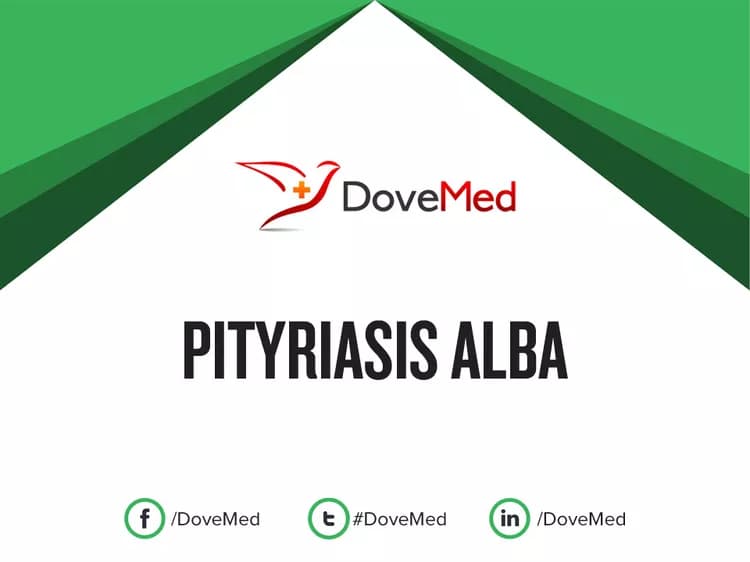What are the other Names for this Condition? (Also known as/Synonyms)
- Extensive Pityriasis Alba
- Pigmenting Pityriasis Alba
- Pseudoleukoderma (Pityriasis Alba)
What is Pityriasis Alba? (Definition/Background Information)
- Pityriasis Alba is a common benign and chronic skin disorder generally occurring in children and teenagers
- It is characterized by the appearance of white, pale, hypopigmented patches on the face and skin of the other areas (upper trunk)
- The cause of the condition is unknown, but it is associated with allergic conditions (eczema and asthma)
- The symptoms are treated with moisturizers and topical steroid creams. The prognosis of Pityriasis Alba is usually very good
Who gets Pityriasis Alba? (Age and Sex Distribution)
- Pityriasis Alba generally affects children between 3 and 16 years old
- It is more common in males than in females
- More frequent attacks of Pityriasis Alba are found in individuals with a lighter skin, but the condition is more apparent in individuals with a darker skin
What are the Risk Factors for Pityriasis Alba? (Predisposing Factors)
The risk factors associated with Pityriasis Alba are:
- Asthma: It is an allergic airway disease causing breathing difficulties, usually in children
- Hay fever: It is an allergic condition characterized by runny nose, itchy eyes, congestion, and sneezing
- Eczema: It is a chronic skin disorder characterized by scaly and itchy rashes
- Excessive dry skin
It is important to note that having a risk factor does not mean that one will get the condition. A risk factor increases ones chances of getting a condition compared to an individual without the risk factors. Some risk factors are more important than others.
Also, not having a risk factor does not mean that an individual will not get the condition. It is always important to discuss the effect of risk factors with your healthcare provider.
What are the Causes of Pityriasis Alba? (Etiology)
- The exact cause of Pityriasis Alba is unknown
- The disorder is associated with a history of atopy, as many children with Pityriasis Alba also have eczema and other allergic conditions. Atopy is a predisposition towards developing certain allergic reactions
Individuals who have brighter pigment in their skin get Pityriasis Alba with higher frequency than those with darker skin. In darker-skinned individuals, the skin condition is more visible and apparent, especially during spring and summer.
What are the Signs and Symptoms of Pityriasis Alba?
The common signs and symptoms of Pityriasis Alba include:
- Appearance of light-colored patches on the cheeks, around the mouth, chin, forehead, neck, shoulders, upper chest, and upper arms
- Skin may also be flaky with scales
How is Pityriasis Alba Diagnosed?
The diagnosis of Pityriasis Alba may include:
- Complete evaluation of medical history along with a thorough physical exam
- Wood’s lamp examination of the skin
- KOH (potassium hydroxide) test to ensure that there is no associated fungal infection
- Skin biopsy: An examination of a tissue sample under the microscope by a pathologist. This is required in cases where the diagnosis is in doubt and cannot be made through a physical exam alone
Many clinical conditions may have similar signs and symptoms. Your healthcare provider may perform additional tests to rule out other clinical conditions to arrive at a definitive diagnosis.
What are the possible Complications of Pityriasis Alba?
The possible complications Pityriasis Alba can lead to include:
- Pruritus - itching sensation
- Cosmetic issues due to hypopigmentation of the skin
- Treatment side effects
How is Pityriasis Alba Treated?
The treatment of Pityriasis Alba usually involves:
- Application of moisturizers
- Use of mild, topical, steroid creams to reduce itching and redness
- Other topical applications that may be used include emollients, with or without lactic acid or salicylic acid
How can Pityriasis Alba be Prevented?
Preventive measures for Pityriasis Alba include:
- Use of non-soap cleansers
- Regular use of moisturizers
- Use of ointments and creams that do not have strong fragrances
- Avoiding or minimizing exposure to sun; wearing suitable sunscreen to protect from direct sun
What is the Prognosis of Pityriasis Alba? (Outcomes/Resolutions)
- The prognosis of Pityriasis Alba is generally good in most cases
- With proper treatment, the skin condition gets cured within a few months, or it may take up to a year
Additional and Relevant Useful Information for Pityriasis Alba:
- Pityriasis rosea is a benign skin disorder characterized by the presence of skin rashes, affecting individuals between 10-35 years of age
- Pityriasis rubra pilaris is a benign and chronic skin disorder in which the skin becomes red, swollen, rough, and dry, affecting individuals of any age range
Related Articles
Test Your Knowledge
Asked by users
Related Centers
Related Specialties
Related Physicians
Related Procedures
Related Resources
Join DoveHubs
and connect with fellow professionals



0 Comments
Please log in to post a comment.